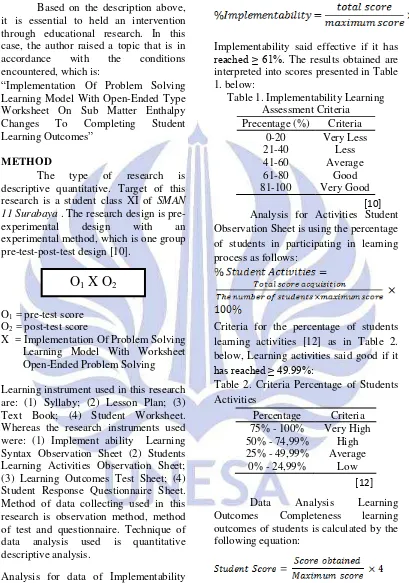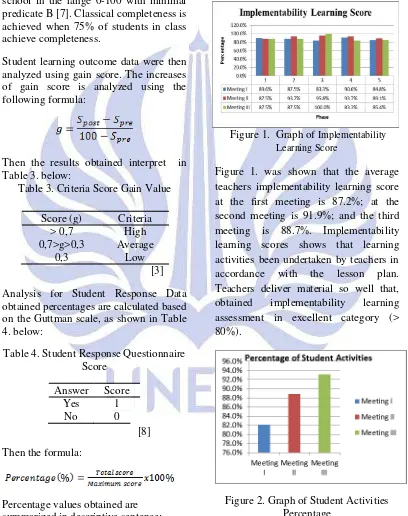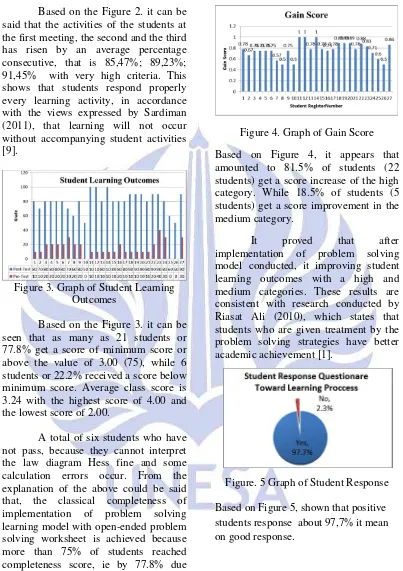133
IMPLEMENTATION OF PROBLEM SOLVING LEARNING MODEL WITH OPEN-ENDED TYPE WORKSHEET ON SUB MATTER ENTHALPY
CHANGES TO COMPLETING STUDENT LEARNING OUTCOMES
Taraprilia Eksiputri, Ismono and Mitarlis Mitarlis Department of Chemistry, FMIPA, Unesa
e-mail: [email protected]
Abstract
The implementation of this research is remedial teaching aimed to completing student learning outcomes , also to describe the learning implementibility, student activities, and student response to the implementation of problem solving learning model with worksheet open-ended problem solving. The method used in this research were observation, tests and questionnaires. The results showed that the learning process through the Implementation of problem solving learning model with worksheet open-ended problem solving, obtain the percentage of learning at the meeting I, II, and III respectively 87.2%, 91.9%, and 88.7% on very good category. Students activity at the meeting I, II, and III get a percentage respectively 82.1%; 88.9%; 93.2% on very high category. Student learning outcomes with the Implementation of problem solving learning model with worksheet open-ended problem solving has been completed that is 77.8% completed individually and student learning outcomes by 81.5% of students (22 students) get gain score with high category and 18.5% of students (5 students) get gain score with moderate category. In addition, the student response after learning process obtained percentage of 97,7% on positive category.
Key Words: student learning outcomes, open ended problem solving, enthalpy changes
INTRODUCTION
Education is an important factor determining the quality of a nation. Based on the Regulation of Ministry Education and Cultural No. 69, 2012 (Permendikbud RI Nomor 69 tahun 2012) on the basic framework and structure of the high school (SMA) curriculum, one of the major challenges that faced as a factor of development of Curriculum 2013 is how do we ensure that abundant human resources in productive age can be transformed into human resources that has competence skills through education so not became a burden. Therefore, education is a basic need for every citizen in the developed countries and in developing countries, to prepare the future generation's life. The basic in education to improve human resources is
learning. For students learn is more than just remembering. To really understand and apply the knowledge, they should work to solve problems, find for something by their self, and always brainstorming for idea[5].
134 Beside it, 39% of students believe that it is because teachers gives less concrete examples and motivation about reactions that exist in the environment also 53% of students believe chemistry is difficult due to the teachers uninteresting delivery. From the result of teachers interviews and questionnaire to 40 students at SMAN 11 Surabaya found that one of the chemical materials that are considered difficult is enthalpy change sub matter. A total of 24% students thought enthalpy change sub matter is difficult because is quite complex and 47% thought is difficult because they lack an understanding of the concept.
Majority thermochemistry learning outcomes of student class XI SMAN 11 Surabaya is still low, at 25% -30% classified in the fail category with minimum completeness criteria 75. These things prove the need of effort to optimize learning in chemistry class particularly in enthalpy change of chemical reaction sub matter with choosing right approach and media. One form of media that can support the learning process is the Student Worksheet. Student worksheet can make learning process becomes better and meaningful. This is in accordance with opinion of Erryanti and Poedjiastoeti (2013) which states that the student worksheet is very feasible to use because it has been get extremely positive constructivist approach that can be applied by many methods, one of them is problem solving. Other researcher found that implementation with problem solving in mathematic learning can improve student thinking ability [4]. Although the study-research on problem solving approach that the author encountered applied in mathematics learning, but it is possible to apply in enthalpy changes sub matter. planting the following concepts also with the use of the calculations on the concept.
Regulation of Ministry Education
and Cultural No. 65, 2013
135 Based on the description above, it is essential to held an intervention through educational research. In this case, the author raised a topic that is in accordance with the conditions encountered, which is:
“Implementation Of Problem Solving Learning Model With Open-Ended Type Worksheet On Sub Matter Enthalpy Changes To Completing Student Learning Outcomes”
METHOD
The type of research is descriptive quantitative. Target of this research is a student class XI of SMAN 11 Surabaya . The research design is pre-experimental design with an experimental method, which is one group pre-test-post-test design [10].
O1 = pre-test score O2 = post-test score
X = Implementation Of Problem Solving Learning Model With Worksheet Open-Ended Problem Solving
Learning instrument used in this research are: (1) Syllaby; (2) Lesson Plan; (3) Text Book; (4) Student Worksheet. Whereas the research instruments used were: (1) Implement ability Learning Syntax Observation Sheet (2) Students Learning Activities Observation Sheet; (3) Learning Outcomes Test Sheet; (4) Student Response Questionnaire Sheet. Method of data collecting used in this research is observation method, method of test and questionnaire. Technique of data analysis used is quantitative descriptive analysis.
Analysis for data of Implementability Learning Using Problem Solving Model is calculated by the following equation[10]:
Implementability said effective if it has reached ≥ 61%. The results obtained are interpreted into scores presented in Table 1. below:
Table 1. Implementability Learning Assessment Criteria
Precentage (%) Criteria
0-20 Very Less
21-40 Less
41-60 Average
61-80 Good
81-100 Very Good
Analysis for Activities Student Observation Sheet is using the percentage of students in participating in learning
Data Analysis Learning Outcomes Completeness learning outcomes of students is calculated by the following equation:
Classical completeness is obtained by the formula:
O1 X O2
[10]
136 Students completed individually when reaching the average score of at least 75 in accordance with minimum score of the school in the range 0-100 with minimal predicate B [7]. Classical completeness is achieved when 75% of students in class achieve completeness.
Student learning outcome data were then analyzed using gain score. The increases of gain score is analyzed using the following formula:
Then the results obtained interpret in Table 3. below:
Table 3. Criteria Score Gain Value
[3]
Analysis for Student Response Data obtained percentages are calculated based on the Guttman scale, as shown in Table 4. below:
Table 4. Student Response Questionnaire Score
Answer Score
Yes 1
No 0
Then the formula:
Percentage values obtained are summarized in descriptive sentence: 0% - 50% = has negative response
51% - 100% = has positive response
RESULT AND DISCUSSION
On learning that has been done, the implementability learning score in the following Figure 1:
Figure 1. Graph of Implementability Learning Score
Figure 1. was shown that the average teachers implementability learning score at the first meeting is 87.2%; at the second meeting is 91.9%; and the third meeting is 88.7%. Implementability learning scores shows that learning activities been undertaken by teachers in accordance with the lesson plan. Teachers deliver material so well that, obtained implementability learning assessment in excellent category (> 80%).
Figure 2. Graph of Student Activities Percentage
Score (g) Criteria
> 0,7 High
0,7>g>0,3 Average
0,3 Low
137 Based on the Figure 2. it can be said that the activities of the students at the first meeting, the second and the third has risen by an average percentage consecutive, that is 85,47%; 89,23%; 91,45% with very high criteria. This shows that students respond properly every learning activity, in accordance with the views expressed by Sardiman (2011), that learning will not occur without accompanying student activities [9].
Figure 3. Graph of Student Learning Outcomes
Based on the Figure 3. it can be seen that as many as 21 students or 77.8% get a score of minimum score or above the value of 3.00 (75), while 6 students or 22.2% received a score below minimum score. Average class score is 3.24 with the highest score of 4.00 and the lowest score of 2.00.
A total of six students who have not pass, because they cannot interpret the law diagram Hess fine and some calculation errors occur. From the explanation of the above could be said that, the classical completeness of implementation of problem solving learning model with open-ended problem solving worksheet is achieved because more than 75% of students reached completeness score, ie by 77.8% due individually.
Figure 4. Graph of Gain Score
Based on Figure 4, it appears that amounted to 81.5% of students (22 students) get a score increase of the high category. While 18.5% of students (5 students) get a score improvement in the medium category.
It proved that after
implementation of problem solving model conducted, it improving student learning outcomes with a high and medium categories. These results are consistent with research conducted by Riasat Ali (2010), which states that students who are given treatment by the problem solving strategies have better academic achievement [1].
Figure. 5 Graph of Student Response
138 CLOSURE
Conclusion
Based on the results of research and discussion, it can be concluded that:
1. Implementability problem solving model have average learning score activity at the first, second and third meeting were very high, the percentage of student activity , respectively; 85,47%; 89,23%; 91,45%
3. The results of student learning has been completed classically that is 77.8% completed and the results of gain score is 81.5% of students (22 students) get a high category and 18.5% of students (5 students) get a medium category.
4. Student responses toward learning process is 97.7%, which positive response it means has good response.
Suggestion
1. This research is limited to an increasing and completing cognitive of students, other researchers expected to increase or train the psychomotor and affective of the students.
2. The Implementation in this research is limited to enthalpy change sub matter, researchers can further develop open-ended problem solving worksheet in all material in chemistry and can apply problem solving strategies in any other learning materials in chemistry.
REFERENCES
1. Ali, Riasat. 2010. Effect of Using Problem Solving Method in Teaching Mathematics on the Achievement of Mathematics Student;Vol 6, No 2 February 2010. Institute of Education &Research University of Science & Technology, Bannu, (NWFP) Pakistan. Published by Asian Social Science.
2. Erryanti, Mei Rachma dan Poedjiastoeti, Sri. 2013. Lembar Kerja Siswa (Lks) Berorientasi Keterampilan Proses Materi Zat Aditif Makanan Untuk Siswa
Tunarungu Smalb-B. UNESA
Journal of Chemical Education Vol. 2 No. 1, pp. 51-58 January 2013.
3. Hake, Richard R. 1998.
“Interactive-engagement versus traditional methods: A six-thousand-student survey of mechanics test data for introductory physics
courses”. American Journal of Physics Vol 66.p. 65.
4. Hutauruk, Aswin. 2014. Penerapan Model Pembelajaran Open-Ended Problem Solving untuk Meningkatkan Hasil Belajar Termodinamika pada Mahasiswa Prodi Teknik Mesin FKIP Unpar. Bandung: Jurnal APTEKINDO ke 7 FPTK Universitas Pendidikan Indonesia.
5. Jannah, Rochmatul dan Novita, Dian. 2015. Development of Student Worksheet With Open Ended Problem Solving Oriented on Enthalpy Changes of Chemical Reaction Subject Matter to Train Student Critical Thingking Skill. UNESA Journal of Chemical Education Vol. 5 No. 1, pp. 120-127 January 2016.
139 Masalah. Surabaya: UNESA University Press.
7. Permendikbud Nomor 104 Tahun 2014 tentang Penilaian Hasil Belajar Oleh Pendidik Pada Pendidikan Dasar dan Pendidikan Menengah.
8. Riduwan. 2011. Skala Pengukuran Variable-Variable Penelitian. Bandung: Alfabeta.
9. Sardiman, A.M. 2011. Interaksi dan Motivasi Belajar Mengajar. Jakarta: Rajawali Pers.
10. Sugiyono. 2011. Metode Penelitian Pendidikan. Bandung: Alfabeta.
11. Sunyono, 2009. Modul Perancangan PTK dan Penelitian Karya Ilmiah. FKIP UNILA. Lampung
12. Yonny, Acep, dkk. 2010. Menyusun
Penelitian Tindakan


